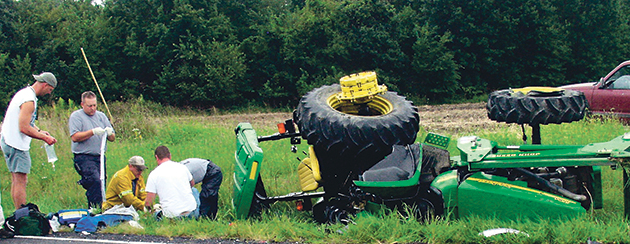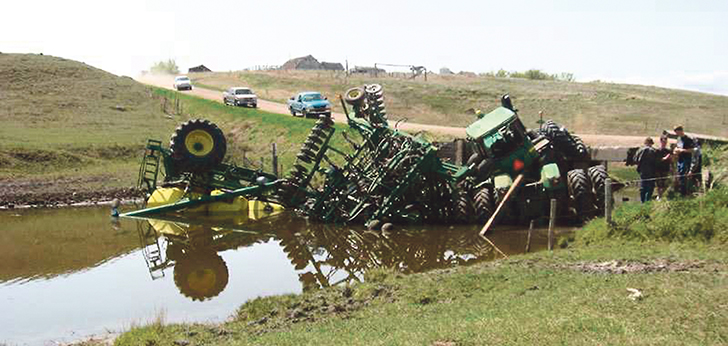Think about this. What happens if 235,000 pounds of four-wheel-drive tractor towing a loaded grain cart loses its brakes going downhill, and the entire rig slams broadside into a school bus full of kids?
It’s not a matter of “if,” says Brian Olson of Power Pin hitching systems in Fort Qu’Appelle Sask. It’s a matter of “when.”
With 30 years of designing and building agricultural hitches, it’s an issue he thinks about often. The fact that farm equipment in North America doesn’t require brakes is troubling the machinery maker.
Read Also

Volatile temperatures expected for this winter
DTN is forecasting a lot of temperature variability in the Canadian Prairies this winter. Precipitation should be close to average.
Olson said that right now, somewhere in North America, the ingredients for that disaster are brewing: maybe your province, maybe your municipality or maybe even your farm.
“A full 2,000 bushel cart with high moisture corn at 65 lb. per bushel carries a 135,000 lb. payload. The cart itself weighs 50,000 lb. The tractor weighs another 50,000 lb. So we’re looking at nearly a quarter million lb. gross vehicle weight. How do you stop that mountain from rolling over you?” Olson said.
“I was a farmer before, so I have some opinions relevant to this discussion. But now I’m in the business of building tractor drawbars. These other guys build grain carts and trailers and other implements towed behind tractors. The stuff some of them are building is way out of standards. They’re busting up tractor interfaces all the time because the weight of the equipment they’re pulling is crazy. And some don’t even bother installing brakes.”

Emergency workers treated Monroe County, Missouri, farmer Kent Blades in 2006 when he was severely injured in a tractor accident. Blades and his family urge drivers to slow down and be watchful of farmers on the road during spring planting season. | Photo courtesy of Linda Blades
Olson has dedicated a large amount of his time over the past three decades working with American Society of Agricultural and Biological Engineers, the Canadian Standards Association and other organizations on these safety issues and has found a lot of politics and infighting.
For example, the committees dealing with standardized hydraulic connectors were deadlocked for years before finally agreeing on a common criteria. He hopes those deadlocks don’t repeat themselves and delay resolution of the trailer brake dilemma.
He said tractor manufacturers have been big supporters of the ASABE in keeping everyone on the same page on safety issues, but the real problem is not the tractor.
The real problem is the runaway iron mountain towed behind the tractor. ASABE recently reviewed the 15-year-old requirements on brakes for farm trailers and carts and decided they badly needed updating.
While serving as a representative for the Agricultural Manufacturers of Canada on the CSA, he compiled a statistical picture of the death and destruction caused by farm equipment on public roads.
“I showed CSA the data and explained simply that we’ve got to … make our equipment safe. If we don’t, one of these days we’re going to have that big accident. And when that happens, all our farm equipment will be legislated right off the public roads,” Olson said.
“It’s not only safety, but what are we doing to these roads? There was a big fight in Wisconsin about 10 years ago over the weight of liquid manure wagons. They previously allowed 80,000 lb., which was the same limit as semi trailers. But they raised the limit for farm equipment to 90,000 lb. gross vehicle weight. I told the committee this equipment was already over weight when it’s empty.”
A secondary safety issue arises as deteriorating roads further contribute to accidents. Olson’s company exports hitches to Europe, installed on Case and Deere tractors.
The hitches must have a homologation number indicating they meet European safety criteria. Inspectors regularly check shipments to ensure they have the proper credentials.
Olson said the better brake systems employed on European tractor are good, but they’re still not up to hauling the heavy loads that are often pulled in North America.
He said one major step forward is to determine which towed units need better brakes. Is it only designated heavy trailers like air carts, grain carts, slurry tanks, forage wagons and NH3 tanks, or do the regulations extend to scrapers and even drills? What about combines, sprayers and four-wheel-drive tractors when they’re not towing a heavy implement?
“To begin with, we have to make farmers more aware of the potential danger,” he said.
“We just assume that implement manufacturers are selling us the safest equipment possible. Not true.… Farmers have to put pressure on these companies.
“Don’t assume that just because your trusted dealer sold you an implement, that he knows it’s safe. Don’t assume everyone has done their due diligence because you’ll find out someday when you’re upside down in a slough somewhere that they haven’t.
“Now the industry is talking tractors rated for 35 m.p.h. to 55 m.p.h. Guys will legally drive a tractor at 55 m.p.h. pulling a fully loaded 2,000 bushel cart to the terminal or to town to pick up the mail. Once you hook that tractor to that loaded grain cart, all your load figures go up exponentially. This will be chaos. This spells death on the highway.”
















